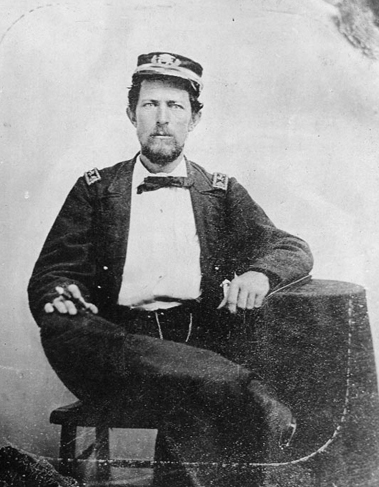Charles
W.
Flusser
Featured Character – 1864 Confederate
Decline

Charles
W. Flusser
Courtesy of the U.S. Naval Historical
Center
Charles Williamson Flusser was born on September 27, 1832, in
Annapolis, Maryland, where in 1847 he entered the U.S. Naval Academy,
graduating in 1853. As
a midshipman, Flusser served in the South American
Squadron during the antebellum period.
Due to
his southern birth, Flusser’s fellow
officers assumed he supported secession.
After hearing rumors of his supposed disloyalty, Flusser
wrote an open
letter to the New
York
Commercial vowing “never” to resign
his commission. Just as secessionist
feelings in Maryland
reached their peak in early 1861, Flusser became
commandant of the Naval
Academy in Annapolis. Ordered to move the
school’s students and
instructors to Newport,
Rhode Island,
Flusser’s loyal actions earned
the attention of the Union high command.
After spending the fall of 1861 on blockade duty off the
coast of Georgia,
Commodore Louis M. Goldsborough selected Flusser for the Burnside
Expedition. The
young officer assumed
command of the Commodore Perry, a
ferry converted into a naval gunboat.
During the Battle of Elizabeth City, Flusser played a
leading role in
the Union victory. With
the departure of
his superior officers for Norfolk,
Flusser
assumed overall leadership of all Union gunboats in the Albemarle
region. During the
Union raid on Franklin,
Virginia
in 1862, the Commodore Perry almost
fell into the hands of Confederate forces.
Only the actions of William B. Cushing saved the ship from
capture. For his
actions, Flusser earned the nickname
“Lion-Hearted Flusser.” As
early as the
winter of 1863, Flusser heard rumors about a Confederate ironclad under
construction on the upper reaches of the Roanoke
River. To
combat this threat, Flusser concentrated
his forces at Plymouth. He roped his two largest
ships, the Southfield and the Miami,
together, with the aim of catching the ironclad between them and
pulverizing
the warship with the larger guns of the Union squadron.
On April 19, 1864, the Confederate Ram Albemarle materialized into fact.
Instead of taking the bait, the ironclad
rammed the Southfield,
pulling all three vessels
together in a confused heap of wood, iron, and brown water. With the ships just feet
apart, Flusser
pulled the lanyard on the Miami’s
largest
cannon; a ten-inch rifled Dahlgren.
The
shell exploded upon impact with the Albemarle’s iron hull,
spreading deadly fragments
across the Miami’s
deck. The
shrapnel killed the entire gun crew, including Flusser. Originally interred at the
military cemetery
in New Bern, in 1868
the Navy transferred his
remains to the Naval Academy.
